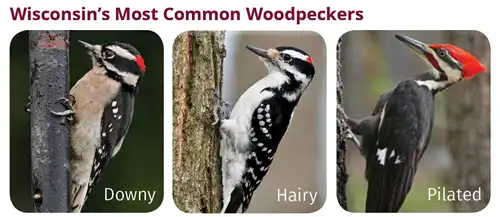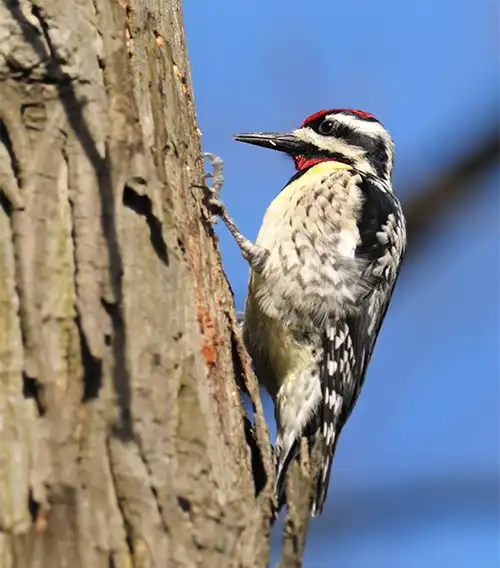Fun to watch as they hammer away, usually gripping sideways on a tree trunk, woodpeckers sometimes become a nuisance. They peck at wood to establish territory, find a mate, excavate a nesting hole, or find insects, and sometimes that wood is attached to a building. They can cause substantial damage if not deterred. Woodpeckers are protected by the Federal Migratory Bird Treaty Act, so it is illegal to intentionally capture, kill or disrupt these migratory birds or their nests and eggs.

Diet
Woodpeckers feed on a variety of insects, especially beetles, ants, caterpillars, and more. They are also fond of black oil sunflower seeds, millet, peanuts, and chunky peanut butter. Occasionally, downy woodpeckers will drink from oriole and hummingbird feeders as well.
Habitat
Woodpeckers usually peck at dead or diseased trees/limbs, but they have also been known to peck at buildings, siding, metal, and air conditioners. They are found mostly in or on the edge of wooded areas due to food prevalence and preference for living in or near trees.
Reasons for Pecking
They peck in order to find food, excavate areas for nesting, or mark their territory.
- If the birds are looking for insects, the holes will be small and irregular. Woodpeckers are particularly fond of the larvae of carpenter bees, leafcutter bees, and grass bagworms.
- They can nest in structures, fences, poles, and sign posts. A cavity is created by the male and female to make a nest in dead limb or dead tree, usually 12-30’ above ground. The cavity entrance is often surrounded by fungus or lichen, helping to camouflage site.
- Because it makes a satisfyingly loud noise that proclaims the bird’s territory and attracts a mate. If the birds are drumming for these reasons, they will most likely stop once breeding has begun in the spring
Prevention
Because woodpeckers can be very persistent and are not easily driven from selected pecking sites, any woodpecker control effort should be started as soon as the problem begins. Woodpecker prevention is based upon physical barriers and scare techniques.
- Physical barriers created in pecking areas will help get rid of woodpeckers by preventing entry. Commonly these are made of steel mesh.
- Shiny, bright objects used as visual deterrents are successful. Strips of aluminum, reflective tape and pinwheels are common objects used.
- Noise scare techniques are also effective in some cases.
Professional Help
Since it is legal to kill woodpeckers, it is best to get help from a professional.

